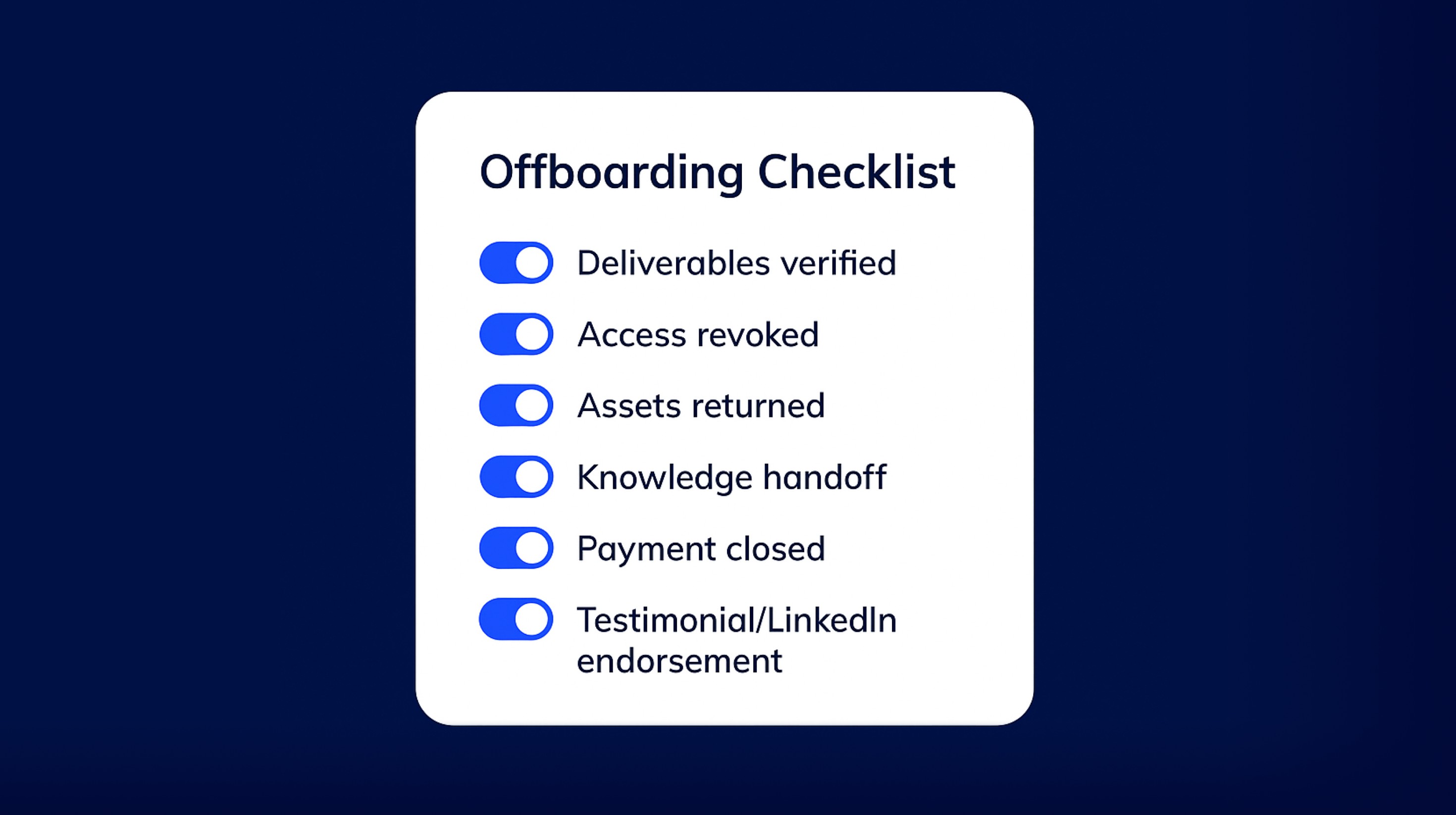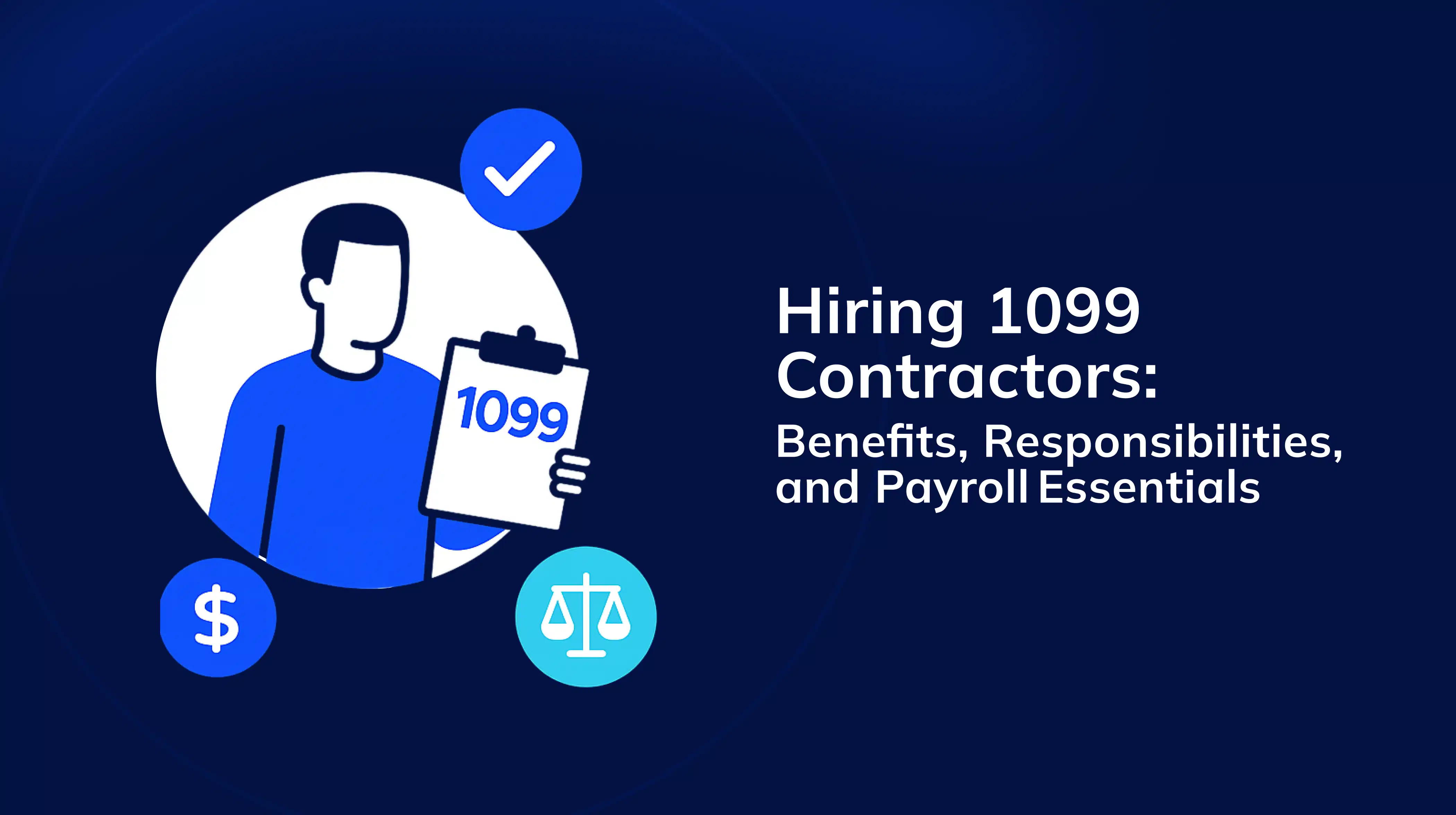In 2025, more than 42 million people in the U.S. work independently—a massive pool of talent ready to plug into your business.
But tapping into that talent comes with strings. HR and finance teams must ensure timely pay, clear contracts, and airtight compliance with classification and tax laws.
This guide breaks down everything you need to know, from setting up payroll to legal responsibilities. You’ll also see how a platform like RemotePass makes managing global contractors simpler, faster, and far less risky.
Why Hire 1099 Contractors?
1099 contractors are a US-based, go-to solution for companies seeking budget-conscious staffing. They offer a rare combination: cost control, specialized skills, and global reach. Here’s a breakdown of these benefits:
Cost Flexibility
“Contractors provide a lower-cost, more flexible model,” says Jennifer Zick, Founder of Authentic. Instead of taking on the commitment of a full-time hire, you pay only for the work delivered. That means fewer fixed costs, no salaries during downtime, and more budget headroom to scale when needed.
There’s also no obligation to provide benefits like health insurance, paid leave, or development stipends. For HR and finance teams, that means access to in-demand talent without the overhead that comes with traditional employment.
Specialized Expertise On Demand
Hiring 1099 contractors gives you fast access to niche skills without the long-term commitment. These professionals are often ahead of the curve, continually sharpening their craft to stay competitive in their field.
Need a designer for a campaign? A developer for a one-off build? Contractors step in with deep expertise, skip the onboarding delays, and get to work—no headcount approvals, no handoffs, no HR complexity.
Scalability
Contractors give your team the ability to flex. Need more hands during a busy season? Spin up support fast without adding headcount or drowning your HR team in admin.
Instead of hiring W-2 employees for short-term needs, you can bring in independent professionals to manage demand spikes without burning out your core team or cutting corners on quality.
Amazon is a typical example. In 2024, the company hired 250,000 temporary workers to handle customer fulfillment and transportation during the festive season, maintaining efficiency while keeping costs low.
Global Reach
Hiring U.S.-based freelancers doesn’t mean limiting yourself to one geography. Many are citizens or residents living abroad, giving you access to global talent without the need to set up local entities or wrangle with foreign labor laws. This approach lets you scale into new regions quickly through contractor agreements, not legal headaches. You get diversity, speed, and reach, minus the paperwork.
Key Legal & Tax Responsibilities
Hiring 1099 contractors comes with serious legal obligations. Misclassification can lead to back taxes, fines, and audits. To stay compliant, you’ll need to understand how the IRS draws the line between contractors and employees.
Classification Rules
In the USA, the Internal Revenue Service (IRS) uses the Common Law test to determine whether a worker is an independent contractor. The test evaluates:
- Behavioral control: Does your company direct how, when, and where the work is done?
- Financial control: Does your company dictate payment terms, reimbursable expenses, or provide tools and equipment?
- Relationship type: The type of relationship between the employer and the contractor. Are there written contracts, employee benefits, or expectations of a long-term relationship?
If a contractor looks and operates like an employee, the IRS will treat them as one. That means penalties, back pay, and potential legal fallout.
Required Documentation
Before any work begins, make sure your paperwork is airtight. The right documentation protects both your business and the contractor and keeps you out of IRS trouble.
- Written contract: Every engagement needs a contract. Spell out the scope of work, deadlines, payment terms, IP rights, confidentiality clauses, and how either party can terminate the agreement. Crucially, it should state that the contractor is not an employee and is responsible for their own taxes and benefits.
- Form W-9: This tax form collects the contractor’s name and Taxpayer Identification Number (TIN). You don’t submit it to the IRS, but you must keep it on file for at least four years.
- Form 1099‑NEC: If you pay a contractor $600 or more in a calendar year, you’re required to file this form with the IRS and provide a copy to the contractor by January 31. It reports their total compensation and TIN—missing the deadline can mean penalties.
State & Local Variations
Not all contractor rules are created equal. While eight states and D.C. follow the IRS’s Common Law Test, 33 states—including California and Massachusetts—enforce the stricter ABC Test, which assumes a worker is an employee unless proven otherwise.
Ignore these state-specific rules, and you risk misclassifying your contractors. The safest move? Review local laws before every new engagement. One blanket policy won’t cut it across state lines.
Misclassification Risks
Misclassifying 1099 contractors as employees poses serious legal risks. As Stephanie Gillenkirk, Fractional CFO and Founder of Pittroe Business Services, warns, “if you’re treating a contractor like an employee but skipping the paperwork, you’re playing with fire.”
That fire can burn fast. Misclassified workers miss out on critical protections like unemployment insurance, overtime pay, and paid leave. According to the Economic Policy Institute (EPI), a misclassified construction worker loses up to $19,527 annually in income and benefits.
Governments take this seriously. Expect audits, back taxes, steep fines, and potential lawsuits. The reputational fallout can sting just as badly as the financial one.
How to Set Up Payroll for 1099 Contractors
Running payroll for contractors isn’t like processing W-2 employees, but it still requires structure, clarity, and consistency. A well-defined setup helps prevent disputes, keeps contractors happy, and protects your business from payment delays or compliance issues.
Select Payment Frequency
Clearly define payment terms in your contractor agreement to prevent disputes and manage expectations. Common payment structures for contractors include:
- Periodic Payments: Contractors receive a set amount on a schedule (hourly, weekly, or monthly) after completing agreed tasks. This setup works well for ongoing work and offers predictability without committing to a full-time salary.
- Project-Based Payments (Milestone or Deliverable-Based): Pay contractors per milestone, invoice, or completed deliverables. You can also offer an upfront deposit and balance up upon project completion. It’s a smart structure for short-term or scoped projects, especially when you want to tie payments to outcomes.

Determine Currency & Transfer Method
When paying U.S.-based contractors, stick to U.S. dollars. It simplifies reporting, avoids conversion headaches, and ensures IRS compliance.
Common legal transfer methods include:
- Direct bank transfers like wire and Automated Clearing House (ACH), ideal for security and compliance.
- Payment platforms like PayPal and Wise, offering speed but with potentially high processing fees.
- Cryptocurrency or digital wallets, such as Apple Pay, Venmo, offering enhanced security and faster transactions
- Contractor of Records (CORs) like RemotePass, best for built-in compliance and tax filing support, even for scaling teams.
Whatever method you choose, factor in fees, payment speed, and how easy it is to track transactions at scale.
Adopt a Unified Payroll System
Contractors care about two things when it comes to pay: speed and transparency.
But without a centralized system, tracking invoices, managing taxes, and staying compliant across states can become a full-time job for your HR or finance team.
That’s where automation pays off. Platforms like RemotePass let you:
- Pay in 90+ currencies
- Consolidate contractor payouts into one invoice
- Automate tax form generation and compliance
- Eliminate errors from manual entry or currency conversion
The result? Fewer delays, fewer mistakes, and a smoother experience for both sides of the table.

Create Standardized Invoices
Messy invoices lead to missed payments and friction. Standardizing your invoicing process avoids disputes and keeps things running smoothly.
Each invoice should clearly show:
- Services delivered or milestones completed
- Hours worked (if applicable)
- Agreed rates
- Total amount due
- A due date: Net 7, 30, EOM, or a fixed calendar date
Professional, consistent invoices not only make life easier for your finance team, they signal to contractors that you take timely payment seriously.
Offer Contractor Benefits & Stipends
Contractors don’t expect traditional benefits but thoughtful perks can still go a long way. A small investment in the right incentives can boost morale, increase referrals, and position your company as a contractor-friendly brand.
Think:
- Learning stipends
- Home-office allowances
- Software subscriptions
- Gym memberships
These extras show appreciation without the baggage of full-time employment.
That said, keep it compliant. Frame perks as performance-based rewards, not entitlements. Offer them to top performers only, and stay well below thresholds that might suggest employee status.
Best Practices for Managing 1099 Relationships
Regular Check‑Ins
Since most 1099s juggle multiple clients, regular check-ins keep your project top of mind. Schedule follow-ups via email, weekly video calls, or async tools like Slack or Trello to monitor progress, address challenges, and gather feedback.
Regular check-ins, even if brief, can help 1099 workers feel supported. As David Case, President at Advastar, notes, “balancing autonomy with clarity is the key to managing 1099 workers effectively and getting the most out of these relationships.”
Feedback & Performance Tracking
Paying on time is table stakes. To get real value, you need visibility into contractor performance.
Don’t just hire and pay contractors; monitor performance and gather feedback to be sure they’re driving real business outcomes and are aligned with your business goals. Leyda Lazo, CEO of Human Capital Consultants, nails it: “Insights into work assignments help assess risk and maintain business oversight.” Use a simple scorecard to track metrics like:
- Quality of work
- Timeliness
- Communication
It doesn’t need to be fancy, just consistent. These snapshots help you decide who to keep, who to upskill, and who to part ways with.
Flip the lens, too. Run periodic NPS-style surveys to gauge how contractors feel about working with your company. Are they satisfied? Would they work with you again? Their responses can flag burnout, confusion, or overwork before it costs you.
Offboarding & Knowledge Transfer
Once deliverables are complete and approved:
- Collect any company-owned assets or documentation
- Revoke access to tools, drives, and internal systems to protect data
- Transfer key knowledge to internal teams or incoming contractors
Take it a step further with a short exit interview. Ask what worked, what didn’t, and how you could improve the experience.
And if a contractor knocked it out of the park? Publicly endorse them on LinkedIn. It’s a small gesture that builds goodwill and attracts high-quality talent back to your bench.

Maintain fair payments
Yes, hiring 1099s cuts overhead but skimping on pay will cost you in other ways.
Underpaying contractors often leads to rushed work, disengagement, and churn. Instead, benchmark market rates for the role and skills you’re sourcing. Then offer pay that reflects both the contractor’s value and the scope of the work.
Fair, competitive compensation signals respect. It builds loyalty and keeps your projects high on their priority list, even when they have other clients.
Satisfy & Retain Contractors with Hassle-free Payments
1099 contractors offer a smart way to stay lean, flexible, and responsive to change. But with that flexibility comes risk, especially when it comes to compliance, misclassification, and payroll.
This is where RemotePass steps in.
As your Contractor of Record (CoR), RemotePass helps you hire confidently with pre-built, compliant templates and a smart editor for instant contract drafting. Our secure e-signature system eliminates paperwork and speeds up onboarding.
We also offer multiple payment methods, including direct bank transfers, PayPal, Payoneer, and cryptocurrency, so your contractors get paid how they prefer. And for top-tier talent, we offer global benefits like health insurance to help you stand out.
Let RemotePass handle the admin, so you can focus on building strong, scalable contractor relationships.

.svg)








.svg)































.svg)








